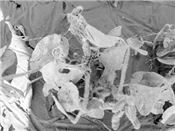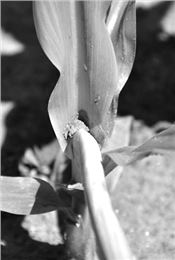Crop Plant Response To Flooding
DR. WILLIAM J. WIEBOLD
COLUMBIA, MO.
The nearly continual heavy rains Missouri has experienced the past month has caused both flash floods and prolonged flooding. Increased runoff can cause water levels in rivers and streams to rapidly rise above flood stage. These flash floods are often short-lived and the flooding water moves rapidly. With prolonged heavy rainfall, even in locations outside of Missouri, water levels in our rivers rise, and this blocks runoff from our fields. Rivers and backed up streams will remain above flood stage until water can drain through the system. Low areas in fields with slow or poor drainage can experience ponding even if separated from rivers or streams. In this type of flood, water will collect in a portion of, or perhaps, the entire field. This type of flood may last longer than flash floods, and the water will be moving very slowly or not at all.
The primary damage to plants (other than lodging) from flooding or ponding is oxygen deprivation. Oxygen content of water is much lower than of air – even air within the soil. Water in soil (water-logging) or above the soil surface (flooding) means there is much less oxygen available to plants. Plants require oxygen for respiration from which high energy compounds are made. These compounds are required for nearly all other life reactions including yield production. Low oxygen availability means that the entire process of respiration slows. If oxygen levels decrease too much, plant respiration changes to a pathway similar to fermentation. While some live-sustaining energy is produced during fermentation, energy production is reduced up to 95 percent. Low oxygen availability (anoxia) means sharply reduced plant growth and, if long enough in duration, plant death.
In addition, fermentation produces several chemicals including lactic acid, acetaldehyde, and ethanol that can be harmful to plants. The most problematic chemical is lactic acid, not from direct toxicity, but because of its effect on cell pH. Accumulation of lactic acid lowers pH. If pH drops too much, cell enzymes denature or precipitate out of solution and the reactions they control stop. Plant death and tissue damage are often caused by this acidosis.
The ultimate effect of flooding on plants is affected by at least three factors: the temperature of the water, the speed of water motion, and the duration of the flood. Temperature is related to the speed of respiration. The faster the respiration the quicker oxygen is depleted and the sooner fermentation begins. Warm water speeds respiration and oxygen use.
Fast moving water creates turbulence. This turbulence oxygenates the water, slightly. Increasing oxygen content of the water through turbulence decreases the impact of flooding on plants, but only slightly. Duration of the flood is important because many of the effects of low oxygen on plants are reversible, up to a point. Long durations allow for increased oxygen depletion and the build up of harmful chemicals. Although local conditions influence susceptibility of plants to flooding, two to three days is the often the tolerable limit.
Soil drainage properties can aggravate the flooding effect. Soils high in clay content or with other drainage restrictions prolong the flooding and remain water-logged after flood waters recede. Soils within the northeast region of Missouri possess a thick claypan. This claypan restricts or nearly prevents downward movement of water. Many days of no rain will be required to move water out of these soils.
Location of the plant’s growing point may affect response to flooding. In general, corn can tolerate flooding better than soybean. But, if flooding occurs while plants are young, the corn growing point is near the soil surface (below or above) making it likely to be submersed longer. The soybean growing point is located at tip of stem and may remain above water.
Effects from flooding may last long after flood waters recede. Soybean plants may turn yellow because oxygen for nodule function had been reduced. This nitrogen deficiency should be temporary. Corn may suffer from N loss through denitrification and/or leaching. Unless more N is supplied, permanent yield reduction is possible. Sometimes flood waters deposit silt and residue on leaves. Photosynthesis will be reduced until the soil and residue are washed from the leaves by subsequent rain. Finally, roots are often damaged and will be more susceptible to diseases. Disease symptoms may not appear until several weeks or even months after the flood event. ∆
DR. WILLIAM J. WIEBOLD: Professor, Division of Plant Sciences, University of Missouri

Ponded water in soybean field.

Flooded soybean plants covered with soil.

Flooded corn plants with soil leaf whorl.